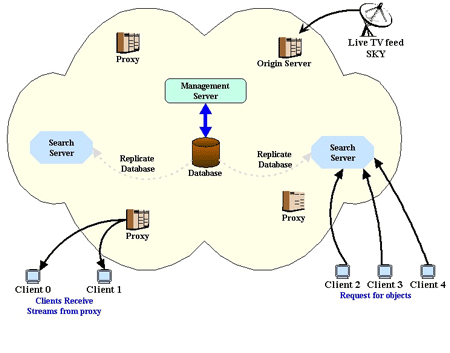
This issue in pdf Subscription Archive: Next issue: October 2005 |
|
||||
A Networked Approach to TV Content Distributionby Adrian Cahill, John Roche and Cormac J. Sreenan The combination of broadband access and packet internetworking removes the existing spatial constraints for TV viewing by allowing residential users to obtain content that originates in any country. Allied with high-capacity networked storage, the temporal constraints can also be removed by ensuring ubiquitous access to a comprehensive library of stored TV content. This compelling vision presents several important research challenges in the area of efficient and scalable content distribution networks for high-quality streaming media. Research taking place at University College Cork in Ireland under the direction of Prof. Sreenan is creating the elements that are needed to make this vision a reality. For his PhD degree, Adrian Cahill is investigating novel approaches for cost-effective management of TV content on a content distribution network (CDN) – work that is part-funded by AT&T Labs USA. John Roche has designed and implemented an experimental network-based digital video recorder as part of his MSc research. The research commenced in 2001 and is nearing completion. This research is motivated by several factors, including the penetration of broadband access and digital set-top boxes, availability of sophisticated techniques for bandwidth management and quality of service, and the popularity of personal digital video recorders. The latter are a class of home appliance that allow a user to record TV content with features for shifted time viewing, but strictly limited in their range of available content and capacity. The proposed system model is shown in the figure and envisages set-top box clients accessing network-based proxy storage servers which are organised into a large-scale CDN.
The various elements of the architecture are:
Clients connect to the Search Server and select the object to view, the search server redirects the client to the most appropriate Proxy Server that can deliver the object, and a streaming session is initiated. The system is technically a hybrid CDN/Peer-to-Peer architecture, consisting of proxies that are leased on-demand from Internet Service Providers and Network Operators. The proposed architecture enlists the use of idle ISP proxies during times of high load, and later, when the requests abate, the proxies are released from the network. The use of leased servers in this manner is an especially interesting and challenging feature of the work, and one which appears attractive from a commercial perspective in relation to deployment costs and operational flexibility. Currently, the main focus of the work is on the computational placement problem, which involves deciding upon the number and location of the replicas within the network. The effectiveness of our architecture can be greatly affected by the placement strategy in use. If too many replicas were created, then storage resources would be wasted, whereas too few replicas would increase the distance (network hops) between the clients and the servers, possibly resulting in degraded performance. These factors and others need to be considered when deciding upon an optimal placement strategy. Finally, this placement strategy needs to be constantly evaluated, as object freshness and popularity diminishes over time. One solution to finding the optimal placement for video objects is to take all aspects of the problem and formulate a cost function. This cost function evaluates all placement instances and identifies the placement layout that yields the lowest resource usage. This is computationally expensive so a heuristic approach is used based on a hierarchical architecture that first decides the general region of the network for the replica placement and then performs an in-depth evaluation of all possibilities within this region. An experimental networked digital video recorder has been implemented to gain experience with the approach. Programme listings for all available channels are provided through an Electronic Programme Guide (EPG) based on ETSI naming standards. A GUI enables searching on a variety of information including:
Yet-to-be-broadcast programmes that are identified in search results may be recorded by simply selecting an option on the GUI. Recording requests are sent to the network-based Management Server where a suitable Proxy is identified to complete the recording task. Whilst a programme is airing it is encoded by an Origin Server and transmitted by multicast to the designated Proxy and any clients wishing to view the programme in real-time. Proxy servers provide VCR-like functionality and content delivery is enabled by the utilisation of standard streaming protocols - Real-Time Streaming Protocol (RTSP) and Real-Time Transport Protocol (RTP). Link: Please contact: |
||||


